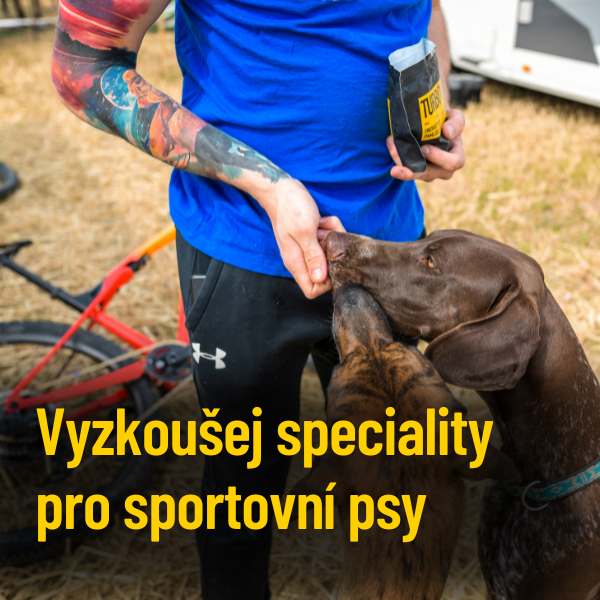We start with agility + instructions on how to teach a dog to delay

We start with agility + instructions on how to teach a dog to delay
Agility is an exciting and fun dog sport that requires a combination of speed, agility and obedience. This activity is not only physically demanding for dogs and their owners, but also strengthens the bond between them. So it's no wonder that it has gained such popularity in recent years. Do you want to take up this sport with your partner? Let's take a look at the basics!
Parkour
The standard parkour includes jump and zone obstacles, tunnels and slalom. Length and complexity vary. A properly built parkour has a clearly defined minimum and maximum number of obstacles that are placed safely with regard to the size category of the dog.
Size category
There are 4 size categories at FCI international competitions:
S (Small): for dogs measuring less than 35 cm at the withers
M (Medium): for dogs measuring 35 cm and more at the withers, but less than 43 cm
I (Intermediate): for dogs measuring 43 cm and more at the withers, but less than 48 cm
L (Large): for dogs measuring 48 cm and more at the withers
Obstacles
Obstacles are divided into three categories.
Jumping (single jump obstacle, double jump obstacle, circle, wall, long jump).
Zones (beam, swing, A).
Others (tunnel, slalom).

Dog and handler
Agility is a team sport between a dog and its owner. The dog must listen to the owner and overcome obstacles in the correct order and direction. It takes years of practice before a handler learns to reliably guide his partner. Therefore, only short and simple sequences are run in the beginning.
Time and flawlessness
The goal is to complete the track as quickly as possible and without mistakes. Each mistake, such as failure to perform or the wrong crossing of an obstacle, adds penalty points . Agility requires speed and precision. Don't be sad if your dog seems slow on obstacles at first. As a general rule, most dogs gain speed over time as they become more confident on the track. Speed comes with understanding. So just repeat and be consistent during training. Regular training will help you strengthen your dog's skills. Definitely don't expect to run the entire course on your first run. In the beginning, only individual obstacles, movement and interplay between the handler and the dog are trained.
Basic commands
The dog should be able to respond to basic commands. A reliable snooze will help you a lot in the beginning. Thanks to it, the owner can prepare in the right place, which will facilitate guidance throughout the run. For a large number of competitors, it can affect the entire course of the race. But it is not a condition. Do not despair if you do not have a postponement - the coach will help you with everything.
Self-control, ability to work in a busy environment and recall are key. There is usually a lot of noise, people and barking dogs around at races. So train to work in every possible environment. Nouse touch will help you a lot during your first training sessions. So if you know you want to try this sport sometime, it's one of the great exercises to know.
Rewards
For canine eaters, we recommend Dogula , which are the ideal reward for sports. It doesn't crumble - so you don't have to worry about leaving unnecessary crumbs on the playground. Turboballs will give your furry friend the right energy he needs during such a physically demanding sport. All our treats have only the best ingredients.
Agility can be an exciting way to spend time with your dog, strengthen obedience and improve physical condition. Remember that this is a team effort between you and your dog , and that basic training and techniques are key to success.
Be patient, have fun and enjoy your time with your four-legged friend. First and foremost, it is always about enjoying this sport to the fullest. We definitely recommend finding a coach to help you learn all the obstacles reliably and confidently.
We wish you good luck!
How to teach a dog to snooze?
Delay is one of the basic commands, so let's take a brief look at how to teach this command.
Step number 1
Have your dog sit in front of you. At first, reward only endurance in the position. You can choose any command, but the most frequently used ones are stay or wait . It is important to always say the command only once , wait and reward endurance.
Step number 2
We start moving away from the dog. As a first step, all you have to do is indicate that we want to back off and immediately go back to the dog and reward him for staying in the sitting position. Gradually convert these hints into steps. One step, two, three... every time you back away from the dog , it is important to return to him again and reward him in the position in which he is put down. In this way, we gradually become more and more distant. If by chance the dog fails and breaks the position, reduce the demands on the next attempt so that it has a better chance of being successful.
Step number 3
Once you can back away from your dog for a few steps and have reliable stamina, it's time for the more creative part of the training. Start engaging harder positions and jammers. For example, you can try to turn your back to the dog, walk around it in a circle, move your arms and legs, jump in place. In other levels, you can wave toys, throw treats, try to run away from the dog. Engage your imagination and practice all kinds of distractions and positions.
A tip at the end
The important thing is that your partner has more correct attempts than wrong ones. So take it slow and don't rush into anything. You can then try the postponement in other different positions. For example, in a lying position, in a position, or during a trick.
This article was prepared by Domika and Malie .








